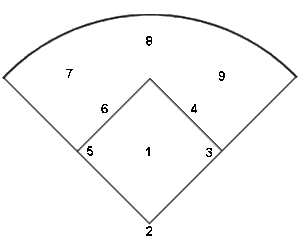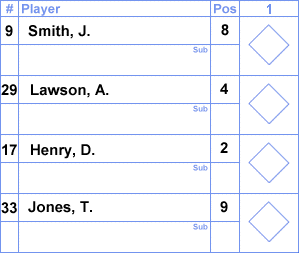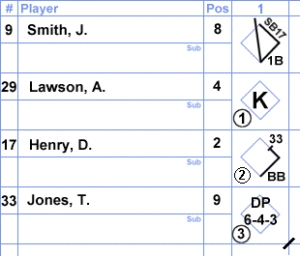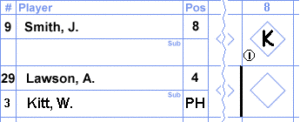The Baseball Scorecard
Info provided by Patrick A. McGovern. Please visit http://www.baseballscorecard.com for more details.
Announcements: Teams are formed through open tryouts that are held in December/January for the Spring and August/September for the Fall.
Getting a Scorecard
When you go to a baseball game, you’ll probably see a vendor selling official programs for about $3 or $4. Outside some ballparks there might be a vendor who is selling an unofficial program for less. Programs are great sources of information about the teams and players that are playing that day. They also contain a scorecard. If you don’t want to use the scorecard from the ballpark, you can buy a book of them at a sporting goods store. You can also create one, making it as simple or complex as you like. It’s not difficult. If you prefer, you may download and use one of these simple scorecards. If the simple scorecards are not adequate, check out this download page.
Looking at a Scorecard
Now that you’ve got a scorecard, take a look at it. There will be areas for different kinds of data, like game day information, batter performance, inning totals, and pitcher performance. Most scorecards will also contain an area to record a summary of the players’ game performance afterwards. The summary area should contain the following information for each batter: at-bats, runs, hits, runs batted in, and errors. Once you tally this information, you’ll be able to compute all sorts of statistics.
Game Data
Once you’ve familiarized yourself with the scorecard layout, it is time to start filling it in. Normally at the top you’ll find places to log information such as team names, date, and time. Some scorecards also contain spaces for location, temperature, weather, team win-loss records, and several other statistics. Some cards will even provide space for umpire and coach names. Fill in as much as you want, but be sure to fill in the team names, date, and time. If you don’t, you won’t know what game you were scoring when you find the scorecard in the bottom of a drawer a few months later.
Player Data

1 – Pitcher; 2 – Catcher; 3 – 1st Base; 4 – 2nd Base; 5 – 3rd Base; 6 – Shortstop; 7 – Left Field; 8 – Center Field; 9 – Right Field
Next, find where you’ll be entering player data. This will be a grid with inning numbers and other designations running across the top and spaces for the players’ names, numbers and positions down the side. Fill these in when the batting order is announced. Before entering the player positions, you should be aware of one standard way of recording them. Instead of alphabetic abbreviations, most people assign numbers to the positions. The standard position numbers are shown below.
A designated-hitter is represented by “DH”.
These numbers are easy to remember if you start with the pitcher and then work your way around the bases. The only hitch is the shortstop. You would think that the numbers for shortsop and third base should be reversed. One explanation that I’ve read was that the shortstop was not originally considered part of the infield. It was originally part of the outfield as a “short fielder.” I don’t know if this is true or not, but it does explain the number system.
Finally, you’ll notice an area where you can register the statistical totals. Some of these, such as runs and hits, are totaled after each half-inning. Others, such as player and team totals, are tallied after the game has been played. We’ll discuss this section later.
Scorekeeper Shorthand
Scorekeeping is accomplished by a sort of “shorthand,” which is basically a combination of position numbers and abbreviations. Refer to the “Scoring Abbreviation” page to see some common numbers and abbreviations used throughout a game.
Batter Up
Let’s see what we need to do as each player has his turn at bat. We’ll confine ourselves to the top of the lineup.

If you’ve familiarized yourself with the position numbers, you’ll see that the center fielder, second baseman, catcher, and right fielder are the first batters up.
Smith singles to center field. A lot of pre-printed scorecards will have a diamond representing the field in the middle of each box. To mark Smith’s single, we’ll darken the line from home to first and place a 1B next to it. Many people also like to draw a line to show where the batter hit the ball.

Lawson’s up next and he strikes out swinging. A “K” is placed in his box to indicate that he struck out. If it was a called strike three, a “Kc” or a backwards “K” would be placed in the box. A circled “1” is also placed in the box to indicate that it is the first out.
(Alberto Z., a visitor to this site, likes to use “K..” for a called strike three. He says that the two dots look like a pair of eyes watching the last strike go by.)

Henry is batting next, but while he is batting Smith manages to steal second. The line from first to second should be darkened and an “SB” along with a number to indicate who was at bat is written to indicate that Smith stole second during Henry’s plate appearance. I like to use the player’s jersey number for this. It makes it easier for me to keep track of things. Other people use the player’s position number. So, I could have just as easily written “SB2” instead of “SB17”. If Henry hit or sacrificed the batter over to second, you would place just the uniform or player number next to the path from first to second to show how Smith got there.

Henry manages to draw a walk. The line from home to first is darkened and either a “BB” or “W” is written to indicate the walk. I prefer to use BB for “Base on Balls.”

Jones is now at bat and hits it to the short stop who tosses it to the second baseman who tags the bag to get Henry out. The second baseman then throws to first to get Jones out. A classic 6-4-3 double play, which is what is written in Jones’ box. Of course, both outs must be recorded. So a line is drawn halfway between first and second in Henry’s box and is marked with a ’33’ to indicate that Jones was the batter. A circled ‘2’ is also entered to indicate that Henry was the second out.

In Jones’ box a 6-4-3 is written along with a ‘DP’ for the double play and a circled ‘3’ to indicate the third out. A ‘DP’ could also have been entered in Henry’s box to indicate that he was caught up in the double play as well. One other method is to draw a line connecting the two boxes.

The ‘6-4-3’ above is an example of how all players who were involved in putting the runner out are given credit.
Since this is the third out, a slash is drawn across the lower right-hand corner of Jones’ box to indicate the end of the inning. This is what the scorecard should look like after the first half-inning.

Substitutions
There are many reasons to replace a starter: pitchers get tired, batters aren’t hitting, players get injured, someone’s ejected, or the manager makes a strategic move. Whatever the reason, sooner or later you’re going to have to mark a substitution on your scorecard.
So, how do you do this? It depends on the substitution.
For batter substitutions, I draw a line between the last scorebox of the previous batter and the first scorebox of the new batter.

If the new batter is a pinch hitter, place “PH” in the position box. If he is taking a position in the field, use the normal position numbers. If players are moved around in the field, you’ll want to show that on your scorecard. Usually, I make a note by the player’s name indicating the move.
When a substitution is made for the pitcher, place a line under the score box of the last batter the previous pitcher faced.
Back in the Dugout
Now that the game is over, you can tabulate all the data you’ve compiled. If you haven’t been keeping up with it during the game, now is the time to add up the statistics for each inning: runs, hits, errors, passed balls, and men left on base. You can also add up the data for each pitcher: innings pitched, batters faced, strikeouts, walks, hits, runs, earned runs, wild pitches, batters hit, and balks. Professionally printed scorecards may contain several fields to tally a batter’s performance: at-bats, runs, hits, singles, doubles, triples, home runs, runs batted in and others. It’s up to you to decide how much you want to do.
If you want to learn the formulas for calculating batting average, earned-run average, on-base percentage, or several other stats, check out this statistics page.
Finally
The official scorekeeper must prove the official box score, which is what becomes part of the official record. The formula is very simple and must be applied to each teams scorecard.
First, total the number of runs, men left on base and opponents’ putouts for one team. Next, total the number of at-bats, walks, sacrifices, batters hit by pitcher and awards of first base due to interference for the same team. If these two totals are equal than this team’s box score is “proven.” Repeat the process for the other team.
Want to Join The Club?
The SCOTS Baseball Club provides professional coaches who teach the fundamentals of baseball while developing character, teamwork and sportsmanship in young athletes.
The Scots Baseball Club regularly emails parents information about the current and upcoming seasons. This is the best way to stay tuned with the Club. Don't forget to follow us on social media to stay up-to-date with all things Scots Baseball!
